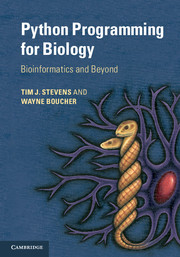Book contents
- Frontmatter
- Contents
- Preface
- Acknowledgements
- 1 Prologue
- 2 A beginners’ guide
- 3 Python basics
- 4 Program control and logic
- 5 Functions
- 6 Files
- 7 Object orientation
- 8 Object data modelling
- 9 Mathematics
- 10 Coding tips
- 11 Biological sequences
- 12 Pairwise sequence alignments
- 13 Multiple-sequence alignments
- 14 Sequence variation and evolution
- 15 Macromolecular structures
- 16 Array data
- 17 High-throughput sequence analyses
- 18 Images
- 19 Signal processing
- 20 Databases
- 21 Probability
- 22 Statistics
- 23 Clustering and discrimination
- 24 Machine learning
- 25 Hard problems
- 26 Graphical interfaces
- 27 Improving speed
- Appendices
- Glossary
- Index
- Plate section
1 - Prologue
Published online by Cambridge University Press: 05 February 2015
- Frontmatter
- Contents
- Preface
- Acknowledgements
- 1 Prologue
- 2 A beginners’ guide
- 3 Python basics
- 4 Program control and logic
- 5 Functions
- 6 Files
- 7 Object orientation
- 8 Object data modelling
- 9 Mathematics
- 10 Coding tips
- 11 Biological sequences
- 12 Pairwise sequence alignments
- 13 Multiple-sequence alignments
- 14 Sequence variation and evolution
- 15 Macromolecular structures
- 16 Array data
- 17 High-throughput sequence analyses
- 18 Images
- 19 Signal processing
- 20 Databases
- 21 Probability
- 22 Statistics
- 23 Clustering and discrimination
- 24 Machine learning
- 25 Hard problems
- 26 Graphical interfaces
- 27 Improving speed
- Appendices
- Glossary
- Index
- Plate section
Summary
Python programming for biology
One of the main aims of this book is to empower the average researcher in the life sciences, who may have a pertinent scientific question that can be readily answered by computational techniques, but who doesn’t have much, if any, experience with programming. For many in this position, the task of writing a program in a computer language is a bottleneck, if not an impassable barrier. Often, the task is daunting and seems to require a significant investment of time. The task is also subject to the barriers presented by a vocabulary filled with jargon and a seemingly steep learning curve for those people who were not trained in computing or have no inclination to become computer specialists. With this in mind for the novice programmer, one ought to start with the language that is the easiest to get to grips with, and at the time of writing we believe that that language is Python. This is not to say that we have made a compromise by choosing a language that is easy to learn but which is not powerful or fully featured. Python is certainly a very rich and capable way of programming, even for very large projects; otherwise we authors wouldn’t be using it for our own scientific work.
A second main aim of this book is to use Python as a means to illustrate some of what is going on within biological computing. We hope our explanations will show you the scientific context of why something is done with computers, even if you are a newcomer to biology or medical sciences. Even where a popular biological program is not written in Python, or if you are a programmer who has good reason for using another language, we can still use Python as a way of illustrating the major principles of programming for biology. We feel that many of the most useful biological programs are based on combinations of simple principles that almost anyone can understand. By trying to separate the core concepts from the obfuscation and special cases, we aim to provide an overview of techniques and strategies that you can use as a resource in your own research. Virtually all of the examples in this book are working code that can be run and are based on real problems or programs within biological computing. The examples can then be adapted, altered and combined to enable you to program whatever you need.
- Type
- Chapter
- Information
- Python Programming for BiologyBioinformatics and Beyond, pp. 1 - 4Publisher: Cambridge University PressPrint publication year: 2015



